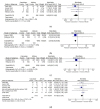The Impact of Recipient Demographics on Outcomes from Living Donor Kidneys: Systematic Review and Meta-Analysis
- PMID: 34884257
- PMCID: PMC8658296
- DOI: 10.3390/jcm10235556
The Impact of Recipient Demographics on Outcomes from Living Donor Kidneys: Systematic Review and Meta-Analysis
Abstract
Background and Aims: Recipient demographics affect outcomes after kidney transplantation. The aim of this study was to assess, for kidneys retrieved from living donors, the effect of recipient sex, ethnicity, and body mass index (BMI) on delayed graft function (DGF) and one-year graft function, incidence of acute rejection (AR), and recipient and graft survivals. Methods: A systematic review and meta-analysis was performed. EMBASE and MEDLINE databases were searched using algorithms through Ovid. Web of Science collection, BIOSIS, CABI, Korean Journal database, Russian Science Citation Index, and SciELO were searched through Web of Science. Cochrane database was also searched. Risk of bias was assessed using the NHBLI tools. Data analysis was performed using Revman 5.4. Mean difference (MD) and risk ratio (RR) were used in analysis. Results: A total of 5129 studies were identified; 24 studies met the inclusion criteria and were analysed. Female recipients were found to have a significantly lower serum creatinine 1-year-post renal transplantation (MD: -0.24 mg/dL 95%CI: -0.18 to -0.29 p < 0.01) compared to male recipients. No significant difference in survival between male and female recipients nor between Caucasians and Africans was observed (p = 0.08). However, Caucasian recipients had a higher 1-year graft survival compared to African recipients (95% CI 0.52-0.98) with also a lower incidence of DGF (RR = 0.63 p < 0.01) and AR (RR = 0.55 p < 0.01). Recipient obesity (BMI > 30) was found to have no effect on 1-year recipient (p = 0.28) and graft survival (p = 0.93) compared to non-obese recipients although non-obese recipients had a lower rate of DGF (RR = 0.65 p < 0.01) and AR (RR = 0.81 p < 0.01) compared to obese recipients. Conclusions: Gender mismatch between male recipients and female donors has negative impact on graft survival. African ethnicity and obesity do not to influence recipient and graft survival but negatively affect DGF and AR rates.
Keywords: BMI; ethnicity; kidney transplant; living donation; recipient’s demographics.
Conflict of interest statement
The authors declare no conflict of interest.
Figures






References
-
- Policies and guidance ODT. [(accessed on 18 November 2021)]. Available online: https://www.odt.nhs.uk/transplantation/tools-policies-and-guidance/polic...
-
- LaPointe R.D., Hays R., Baliga P., Cohen D.J., Cooper M., Danovitch G.M., Dew M.A., Gordon E.J., Mandelbrot D.A., McGuire S., et al. Consensus conference on best practices in live kidney donation: Recommendations to optimize education, access, and care. American journal of transplantation. Am. J. Transplant. 2015;15:914–922. doi: 10.1111/ajt.13173. - DOI - PMC - PubMed
Publication types
LinkOut - more resources
Full Text Sources
Research Materials
Miscellaneous

